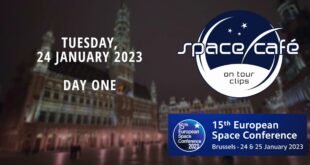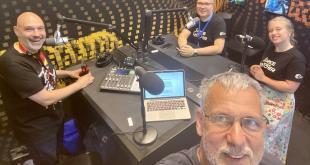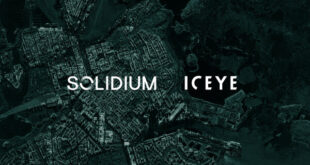by Bano Barzingi and Chiara Moenter
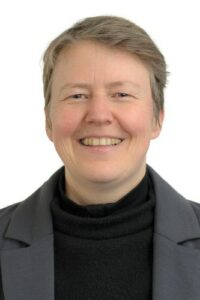
Dr. Hilde Stenuit is a seasoned researcher and team leader for Space Applications Services working to provide fast and direct access to space for research and technology users through the ICE Cubes, or International Commercial Experiment Cubes program. This program offers cube-sized experiments in microgravity allowing or people on Earth to interact directly with their experiments up in space. This past week, space-interested students Bano Barzingi and Chiara Moenter, sit down with Hilde to discuss her work as well as the factors of space sustainability trends and a need for awareness outside of the space sector.
With over 20 years of experience working within the space industry and an immense passion, Hilde’s experience and knowledge are incredibly valuable. Onboard the International Space Station, Hilde, and her team are using the ICE Cubes to conduct research in microgravity. The first ICE Cube was installed by Alexander Gest in July 2018. Ever since, multiple experiments were conducted in life science, biology, fluid dynamics, agriculture, and many other fields.
So what happens if you take gravity out of the equation?
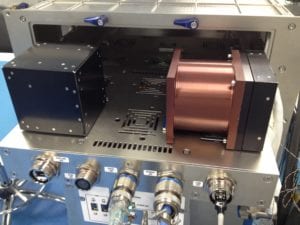
When you can take gravity out of the equation, or out of the processes, or out of the research you can accomplish things you cannot do on Earth. The gravitational environment allows new innovative possibilities for space- and the non-space-sector to conduct experiments.
‘’For example, when you’re doing cell culturing, it’s possible to easily create three-dimensional cell cultures in microgravity than you can’t do on Earth. In fact, when you look at clinical trials for medicines for pharma, a lot of that actually still happens in Petri dishes. These are two-dimensional flat dishes in which they culture cells. Which is not the most representative environment to come in to compare with our body. So, if you know we are able to take away gravity, you see that you can actually create 3D cell cultures that interact in a more representative way of what happens in our body. That is really, very, relevant in then utilizing that environment to bring 3D cell culturing to bring organoids, for example, into these are small mini-organs, let’s say that is representative of the organs in our body, to use the environment and to bring drugs and test them on their space environment, you also get the kind of acceleration of an ageing effect. So, you can also model some diseases better over a space environment.’’
Further developing and experimenting in space will take humanity to a point where we can utilize the space environment. One of the examples that Hilde further elaborates on is fast-tracking experiments. Instead of needing months, the processes will be shortened to several weeks. Especially, if certified space hardware is reused the process will only take five to eight weeks.
Sustainability in Space

Though being a commercial company, with experiments and needs driven by the users, many of the experiments are found to be linked to the United Nations Sustainable Development Goals (SDGs). This unique way of providing experiments in space can give new, unique insights.
“The main thing is we can use this unique environment that you cannot reproduce on earth for really meaningful and sustainable innovation for our humankind.”
There are no direct sustainability criteria placed on defining the focus area of a customer, but by providing access to space for experiments to be conducted, oftentimes research can give insight into topics surrounding agricultural productivity, food production systems, vaccines, and medicines, and many more. Hilde points out that there are many ways to contribute to sustainability and to the SDGs, looking at both potentially positive and negative impacts.
“One is to think in terms of end of life solutions, for example, what do we do to make sure that we’re not making a negative impact? Second one is to contribute in a positive way to research and innovation, and also indirectly through economic development through innovation through education.”
Story Telling for Awareness
Service providers such as Space Service Applications are collaborators who are eager to share stories, Hilde explains. She points out the importance of creating awareness since it is relevant for everyone, to bring the stories together and share knowledge.
‘’We realize over and over again that people are not necessarily aware of one the opportunity or the possibility that they can access space, and two even more important that is relevant for what they are doing. They can actually create value in coming to space for their activities that are not non-space related. But I’m afraid it does pass the message to people that this is something not directly linked to their life on Earth, and that it’s a niche, and that it may be expensive. So, I think it’s really important to tell those stories, specifically of the value it creates for life here on earth. And the value it brings in that sense.’’
Looking out to the Future
The commercialization of space holds many unique opportunities as it provides access even to no-space-related sectors, it will lower the costs of getting to space and will therefore allow for more utilization and applications.
“I think it is part of humankind’s DNA to want to discover and explore and wonder.”
However, to ensure humankind to be able to discover, wonder and marvel, it is necessary to have clear frameworks. There are many initiatives tasked with creating sustainability for space, tackling issues such as space debris but it is crucial moving forward that frameworks are put in place and actively communicated.
Hilde sees that humankind has a future in space and that much of the work being done already are also relevant for a future in space. Topics such as synthetic biology, manufacturing, architecture, and artificial intelligence hold immense potential for new innovations to be born.
“Space is fantastic in the sense that we are obliged to create, by the nature of things, a circular environment. So I mean, all of that, how will we build these initial settlements? Or how can we leverage the research that we are doing today in the most optimal way? That’s all part of our human future in space, definitely.”
To listen to Hilde Stenuit’s insights into space sustainability and commercialization, you can watch the full program here:
To subscribe and get the latest on the space industry from world-leading experts visit – click here.



